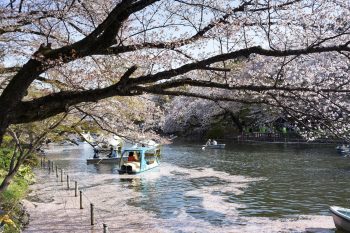March 20th: Spring Equinox in Japan Posted by Philip Gregory on Mar 15, 2020 in Uncategorized
March 20th is fast approaching, and with it comes the annual spring equinox. In Japan, this event is a national holiday called “Shuubun no HI” (春分の日).
In technical terms, an equinox is “either of the two times each year (as of about March 21 and September 23) when the sun (太陽) crosses the equator and day (日中)and night (夜) are everywhere on Earth of approximately equal length” (Merriam Webster). Simply put, it’s the time of year, in spring, when day and night last about the same amount of time.
In Japan, the holiday (祝日) is generally celebrated on March 20th or 21st, depending on the actual equinox, and it is celebrated in a few ways. First, most people have the day off from work. Secondly, though it is now a non-religious holiday that focuses on nature(自然) and the importance of all living things, it also retains much of its Shinto (神道)roots. Much like in the past, Japanese families today often visit the burial sites (墓) of their ancestors, gleaning the gravestones (墓石) and offering flowers(花) and incense (線香) in reverence of those who have passed. Family reunions are also a common occurrence, during this holiday.
Since the Spring Equinox occurs at the end of the Japanese school year, many graduating students hold their graduation ceremonies (卒業式) at this time. The spring equinox marks the first day of spring, so it is no surprise that the cherry blossoms (桜) are flowering at this time, and thus “Hanami”(花見), or flower viewing, is a common activity. On the days just preceding the spring equinox and for three days after, people often make rice dumplings, “Higan Soba”(彼岸そば), or “Udon”(うどん). It is said that, during this time, meat(肉) and alcohol (酒)are forbidden. On the actual equinox holiday, people are found eating “Botamochi”(牡丹餅), a rice dumpling covered in a red azuki bean (小豆) paste.
Now that we’ve covered the basics of the holiday, let’s review the vocabulary.
- Shuubun no HI (春分の日)
- Sun (太陽) – Taiyo
- Day (日中) – Niichu
- Night (夜) – Yoru
- Holiday (祝日) – Shukujitsu
- Nature(自然) – Shizen
- Shinto (神道)
- Burial site (墓) – Haka
- Gravestones (墓石) – Hakaishi
- Flowers(花) – Hana
- Incense (線香) – Senko
- Graduation ceremony (卒業式) – Sotsugyoshiki
- Cherry blossoms (桜) – Sakura
- Hanami (花見)
- Higan Soba (彼岸そば)
- Udon (うどん)
- Meat(肉) – Niku
- Alcohol (酒) – Sake
- Botamochi (牡丹餅)
- Azuki bean (小豆) – Azuki
Studying the Japanese Spring equinox not only gives us a glimpse into modern Japanese sensibilities but also helps us understand the belief systems of their past. It shows us how, even today, many Japanese people respect and revere nature, but it also reveals a deeper historical tradition, in the form of Shinto traditions that are still practiced today. Do you have a Spring Equinox celebration in your country? What vocabulary could a foreigner learn, studying it? Let us know in the comments!

Build vocabulary, practice pronunciation, and more with Transparent Language Online. Available anytime, anywhere, on any device.




